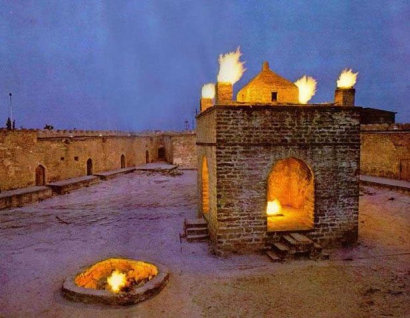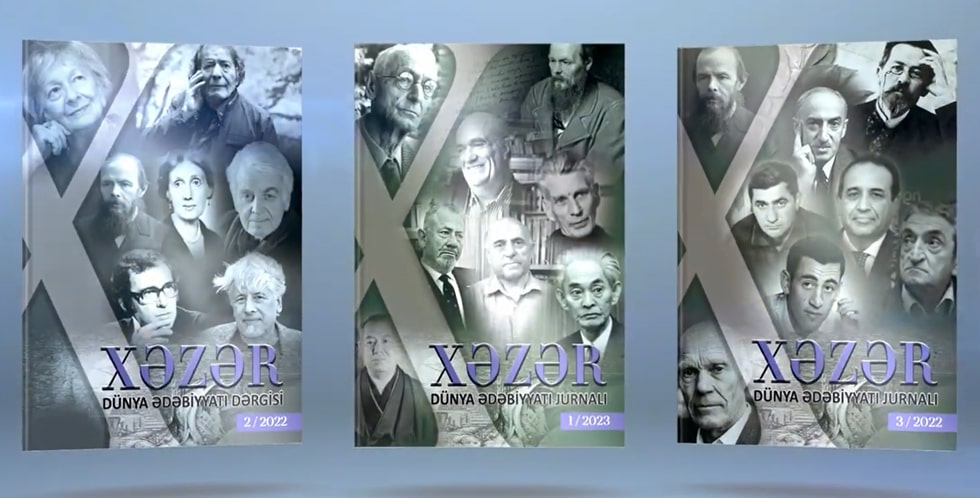Fire-worshippers' places of worship

What was the tie between the great chemist Mendeleyev and the Ateshgah (The Temple of Fire)?
As soon as you enter, you seem to move in Zoroastrian's footsteps instinctively. Our memory, which has been older than us for some thousand years, recognizes these steps and takes us to unknown places where we have never been to. Ateshgah is called a place where fire played with wind. According to historical sources, Ateshgah is one of the rare sacred sanctuaries of the world, which was built at the place of natural gas, the eternal gas, in the XVII-XVIII centuries. The earliest temple part is dated 1713. This place has its own mysticism and magic. Each stone of the Temple seems to greet you from the past.
Presently there are almost 500 Zoroastrians in Azerbaijan, but about 200 thousand Zoroastrians in the world. They mainly live in India and Iran. In Novruz Holiday they visit the main Temple of Fire, say their prayers around the fire and give alms. Alms are mainly fruits. As known from the Avesta, the primary collection of religious texts of Zoroastrianism, an apple, a pear and other fruits are saint for the followers of Zoroastrianism.
There are 20 ancient manuscripts on the cells, 19 in ancient Sanskrit and one in Persian. From the manuscripts you can get information on rich merchants who built the temple. You should pay attention to a point which is very important. The majority of people don't make any distinction between fire-worshippers and Zoroastrians. But there's a substantial difference between them. Zoroastrians accept fire as the communication with God; therefore, they consider fire sacred. Fire-worshippers accept fire as God. Pilgrims who wished to visit the Temple of Fire were mainly rich Indians. According to their world outlook, to spend the last years of their life at the sacred fire and die there meant to be in paradise. So, rich Indian emirs used Surakhany, as they say, as the way to the other world. The etymology of Amirjan settlement's name has ties with this fact. After a long journey rich emirs used to stay in this settlement before going to the sacred temple. After a personal purification, they took the way to the Temple of Fire. It's supposed that the word 'Amirjan' was formed from the phrase 'emirs' place.'
Alexander Duma (father), a French writer, D. Mendeleyev, a great Russian scientist also visited the temple. In their letters Mendeleyev and the Russian tsar Alexander III wrote that the Temple of Fire was one-of-a-kind in the world. D. Mendeleyev, the founder of the contemporary chemistry, visited the Temple of Fire when he was in Baku in 1855. A kerosene mill was being constructed in Baku then. The mill was located behind the Temple, and Mendeleyev was conducting consultations on how to use oil better and not to waste it; he tried to help the mill.
Unfortunately, the place where the scientist was staying and had a lab were destroyed then. Presently houses and other various facilities are located in that area. Nowadays there are only 'memories' about the kerosene mill. It's fact that D. Mendeleyev saw the chemical elements in his dream. When you ask a guide 'if D. Mendeleyev saw the chemical elements in his dream because of the particular mysticism of the Temple', you can't get a positive respond. The guide says that D. Mendeleyev didn't have that dream when he was there. But nobody knows the right answer; maybe the great scientist wish to tie his great discovery just with Russia, his motherland but not with Azerbaijan.
An employee of the Temple spoke about another fact: 'As you know, every year the Novruz Holiday's Flame is lit from the Temple and is taken to Icheri Sheher (Inner City). And the European Games' Flame was also lit at the sacred Temple of Ateshgah. In future, no matter where the European Games are held, its Flame will be lit here.'
During the Novruz Holidays, the number of visitors increases. Even the aura becomes different; it becomes more mysterious, more magical. Visitors are mostly from India and Iran. There are Zoroastrians among them as well. They approach the central temple in the yard of Ateshgah, say their prayers and give fruit alms to the fire. It should be noted that shekerbura, pakhlava, goghal that we have on our tables in Novruz Holiday are the Zoroastrian's symbols. Along with fire, followers of this religion consider the Sun and the Sky sacred too. Therefore, they resemble shekerbura with the Moon, qoghal with the Sun, and pakhlava with stars.
Elmin NURI
AND OTHER...
-
 Isi Malikzade’s Creativity on German Literature Magazine
Isi Malikzade’s Creativity on German Literature Magazine
LESERING.de, a popular German e-literature magazine, has posted in German the short story Salt by Isi Malikzade, the notable Azerbaijani writer, as part of the AzSTC project “Azerbaijan Literature in an International Virtual World”.
-
 Movlud Movlud’s Short Story on Turkish Portals
Movlud Movlud’s Short Story on Turkish Portals
“Detayhaberler.com”, “Dibace.net” and “Haber.232.com”, leading Turkish portals, have posted in Turkish the short story “We Have Already Grown Up” by the...
-
 The Book “The Classification of Words Extracted from “The Spelling Dictionary of the Azerbaijani Language” Out
The Book “The Classification of Words Extracted from “The Spelling Dictionary of the Azerbaijani Language” Out
The Azerbaijan State Translation Centre has published a voluminous book “The Classification of Words Extracted from “The Spelling Dictionary of the Azerbaijani Language”









